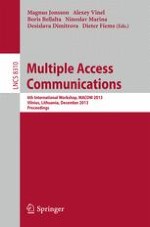2013 | Buch
Multiple Access Communcations
6th International Workshop, MACOM 2013, Vilnius, Lithuania, December 16-17, 2013. Proceedings
herausgegeben von: Magnus Jonsson, Alexey Vinel, Boris Bellalta, Ninoslav Marina, Desislava Dimitrova, Dieter Fiems
Verlag: Springer International Publishing
Buchreihe : Lecture Notes in Computer Science
